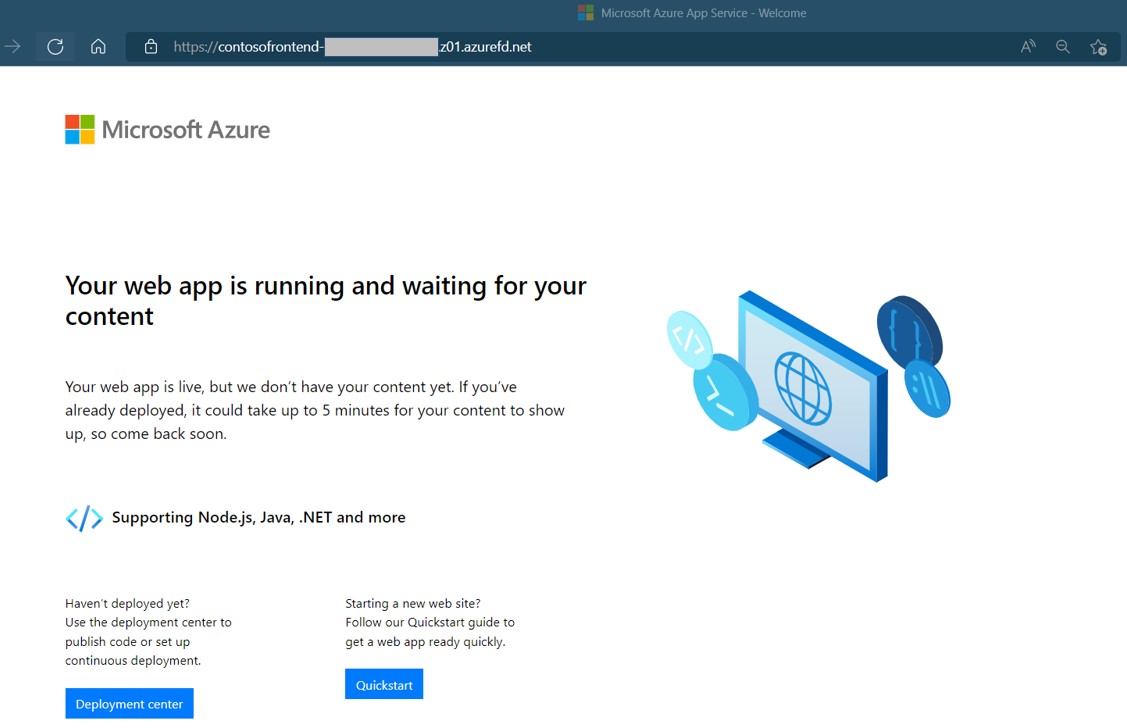你当前正在访问 Microsoft Azure Global Edition 技术文档网站。 如果需要访问由世纪互联运营的 Microsoft Azure 中国技术文档网站,请访问 https://docs.azure.cn。
快速入门:使用 ARM 模板创建 Azure Front Door
本快速入门介绍了如何使用 Azure 资源管理器模板(ARM 模板)创建 Azure Front Door,并以一个 Azure Web 应用作为源。
Azure 资源管理器模板是定义项目基础结构和配置的 JavaScript 对象表示法 (JSON) 文件。 模板使用声明性语法。 你可以在不编写用于创建部署的编程命令序列的情况下,描述预期部署。
如果你的环境满足先决条件,并且你熟悉如何使用 ARM 模板,请选择“部署到 Azure”按钮。 Azure 门户中会打开模板。
先决条件
- 如果没有 Azure 订阅,请在开始之前创建一个免费帐户。
- 网站或 Web 应用程序的 IP 或 FQDN。
查看模板
本快速入门中使用的模板来自 Azure 快速启动模板。
在本快速入门中,你将创建 Front Door 标准版/高级版和应用服务,并配置该应用服务以验证流量是否是通过 Front Door 源传送的。
{
"$schema": "https://schema.management.azure.com/schemas/2019-04-01/deploymentTemplate.json#",
"contentVersion": "1.0.0.0",
"metadata": {
"_generator": {
"name": "bicep",
"version": "0.5.6.12127",
"templateHash": "1359495056007144414"
}
},
"parameters": {
"location": {
"type": "string",
"defaultValue": "[resourceGroup().location]",
"metadata": {
"description": "The location into which regionally scoped resources should be deployed. Note that Front Door is a global resource."
}
},
"appName": {
"type": "string",
"defaultValue": "[format('myapp-{0}', uniqueString(resourceGroup().id))]",
"metadata": {
"description": "The name of the App Service application to create. This must be globally unique."
}
},
"appServicePlanSkuName": {
"type": "string",
"defaultValue": "S1",
"metadata": {
"description": "The name of the SKU to use when creating the App Service plan."
}
},
"appServicePlanCapacity": {
"type": "int",
"defaultValue": 1,
"metadata": {
"description": "The number of worker instances of your App Service plan that should be provisioned."
}
},
"frontDoorEndpointName": {
"type": "string",
"defaultValue": "[format('afd-{0}', uniqueString(resourceGroup().id))]",
"metadata": {
"description": "The name of the Front Door endpoint to create. This must be globally unique."
}
},
"frontDoorSkuName": {
"type": "string",
"defaultValue": "Standard_AzureFrontDoor",
"allowedValues": [
"Standard_AzureFrontDoor",
"Premium_AzureFrontDoor"
],
"metadata": {
"description": "The name of the SKU to use when creating the Front Door profile."
}
}
},
"variables": {
"appServicePlanName": "AppServicePlan",
"frontDoorProfileName": "MyFrontDoor",
"frontDoorOriginGroupName": "MyOriginGroup",
"frontDoorOriginName": "MyAppServiceOrigin",
"frontDoorRouteName": "MyRoute"
},
"resources": [
{
"type": "Microsoft.Cdn/profiles",
"apiVersion": "2021-06-01",
"name": "[variables('frontDoorProfileName')]",
"location": "global",
"sku": {
"name": "[parameters('frontDoorSkuName')]"
}
},
{
"type": "Microsoft.Web/serverfarms",
"apiVersion": "2020-06-01",
"name": "[variables('appServicePlanName')]",
"location": "[parameters('location')]",
"sku": {
"name": "[parameters('appServicePlanSkuName')]",
"capacity": "[parameters('appServicePlanCapacity')]"
},
"kind": "app"
},
{
"type": "Microsoft.Web/sites",
"apiVersion": "2020-06-01",
"name": "[parameters('appName')]",
"location": "[parameters('location')]",
"kind": "app",
"identity": {
"type": "SystemAssigned"
},
"properties": {
"serverFarmId": "[resourceId('Microsoft.Web/serverfarms', variables('appServicePlanName'))]",
"httpsOnly": true,
"siteConfig": {
"detailedErrorLoggingEnabled": true,
"httpLoggingEnabled": true,
"requestTracingEnabled": true,
"ftpsState": "Disabled",
"minTlsVersion": "1.2",
"ipSecurityRestrictions": [
{
"tag": "ServiceTag",
"ipAddress": "AzureFrontDoor.Backend",
"action": "Allow",
"priority": 100,
"headers": {
"x-azure-fdid": [
"[reference(resourceId('Microsoft.Cdn/profiles', variables('frontDoorProfileName'))).frontDoorId]"
]
},
"name": "Allow traffic from Front Door"
}
]
}
},
"dependsOn": [
"[resourceId('Microsoft.Web/serverfarms', variables('appServicePlanName'))]",
"[resourceId('Microsoft.Cdn/profiles', variables('frontDoorProfileName'))]"
]
},
{
"type": "Microsoft.Cdn/profiles/afdEndpoints",
"apiVersion": "2021-06-01",
"name": "[format('{0}/{1}', variables('frontDoorProfileName'), parameters('frontDoorEndpointName'))]",
"location": "global",
"properties": {
"enabledState": "Enabled"
},
"dependsOn": [
"[resourceId('Microsoft.Cdn/profiles', variables('frontDoorProfileName'))]"
]
},
{
"type": "Microsoft.Cdn/profiles/originGroups",
"apiVersion": "2021-06-01",
"name": "[format('{0}/{1}', variables('frontDoorProfileName'), variables('frontDoorOriginGroupName'))]",
"properties": {
"loadBalancingSettings": {
"sampleSize": 4,
"successfulSamplesRequired": 3
},
"healthProbeSettings": {
"probePath": "/",
"probeRequestType": "HEAD",
"probeProtocol": "Http",
"probeIntervalInSeconds": 100
}
},
"dependsOn": [
"[resourceId('Microsoft.Cdn/profiles', variables('frontDoorProfileName'))]"
]
},
{
"type": "Microsoft.Cdn/profiles/originGroups/origins",
"apiVersion": "2021-06-01",
"name": "[format('{0}/{1}/{2}', variables('frontDoorProfileName'), variables('frontDoorOriginGroupName'), variables('frontDoorOriginName'))]",
"properties": {
"hostName": "[reference(resourceId('Microsoft.Web/sites', parameters('appName'))).defaultHostName]",
"httpPort": 80,
"httpsPort": 443,
"originHostHeader": "[reference(resourceId('Microsoft.Web/sites', parameters('appName'))).defaultHostName]",
"priority": 1,
"weight": 1000
},
"dependsOn": [
"[resourceId('Microsoft.Web/sites', parameters('appName'))]",
"[resourceId('Microsoft.Cdn/profiles/originGroups', variables('frontDoorProfileName'), variables('frontDoorOriginGroupName'))]"
]
},
{
"type": "Microsoft.Cdn/profiles/afdEndpoints/routes",
"apiVersion": "2021-06-01",
"name": "[format('{0}/{1}/{2}', variables('frontDoorProfileName'), parameters('frontDoorEndpointName'), variables('frontDoorRouteName'))]",
"properties": {
"originGroup": {
"id": "[resourceId('Microsoft.Cdn/profiles/originGroups', variables('frontDoorProfileName'), variables('frontDoorOriginGroupName'))]"
},
"supportedProtocols": [
"Http",
"Https"
],
"patternsToMatch": [
"/*"
],
"forwardingProtocol": "HttpsOnly",
"linkToDefaultDomain": "Enabled",
"httpsRedirect": "Enabled"
},
"dependsOn": [
"[resourceId('Microsoft.Cdn/profiles/afdEndpoints', variables('frontDoorProfileName'), parameters('frontDoorEndpointName'))]",
"[resourceId('Microsoft.Cdn/profiles/originGroups/origins', variables('frontDoorProfileName'), variables('frontDoorOriginGroupName'), variables('frontDoorOriginName'))]",
"[resourceId('Microsoft.Cdn/profiles/originGroups', variables('frontDoorProfileName'), variables('frontDoorOriginGroupName'))]"
]
}
],
"outputs": {
"appServiceHostName": {
"type": "string",
"value": "[reference(resourceId('Microsoft.Web/sites', parameters('appName'))).defaultHostName]"
},
"frontDoorEndpointHostName": {
"type": "string",
"value": "[reference(resourceId('Microsoft.Cdn/profiles/afdEndpoints', variables('frontDoorProfileName'), parameters('frontDoorEndpointName'))).hostName]"
}
}
}
模板中定义了多个 Azure 资源:
- Microsoft.Network/frontDoors
- Microsoft.Web/serverfarms(托管 Web 应用的应用服务计划)
- Microsoft.Web/sites(为 Front Door 的请求提供服务的 Web 应用源)
部署模板
从以下代码块中选择“试用”,以打开 Azure Cloud Shell,然后按照相关说明登录到 Azure。
注意
如果要部署 Azure Front Door 高级版而不是标准版,请将 sku 参数的值替换为
Premium_AzureFrontDoor。 有关详细比较,请查看 Azure Front Door 层级比较。$projectName = Read-Host -Prompt "Enter a project name that is used for generating resource names" $location = Read-Host -Prompt "Enter the location (i.e. centralus)" $templateUri = "https://raw.githubusercontent.com/Azure/azure-quickstart-templates/master/quickstarts/microsoft.cdn/front-door-standard-premium-app-service-public/azuredeploy.json" $resourceGroupName = "${projectName}rg" New-AzResourceGroup -Name $resourceGroupName -Location "$location" New-AzResourceGroupDeployment -ResourceGroupName $resourceGroupName -TemplateUri $templateUri -frontDoorSkuName Standard_AzureFrontDoor Read-Host -Prompt "Press [ENTER] to continue ..."等到控制台中显示提示。
从上一个代码块中选择“复制”,以复制 PowerShell 脚本。
右键单击 shell 控制台窗格,然后选择“粘贴”。
输入相应的值。
模板部署将创建把 Web 应用用作源的 Front Door
资源组名称是追加了 rg 的项目名称。
注意
“frontDoorName”需要是全局唯一名称,才能成功部署模板。 如果部署失败,请从步骤 1 重新开始。
部署模板需要几分钟时间。 完成后,输出类似于:

使用 Azure PowerShell 部署模板。 除了 Azure PowerShell,还可以使用 Azure 门户、Azure CLI 和 REST API。 若要了解其他部署方法,请参阅部署模板。
验证部署
登录 Azure 门户。
从左侧窗格中选择“资源组”。
选择你在上一部分中创建的资源组。 默认资源组名称是追加了 rg 的项目名称。
选择之前创建的 Front Door,此时可以看到终结点主机名。 复制主机名并将其粘贴到浏览器的地址栏中。 按 Enter,然后请求将自动路由到 Web 应用。

清理资源
如果不再需要 Front Door 服务,请删除资源组。 这会删除 Front Door 和所有相关资源。
若要删除资源组,请调用 Remove-AzResourceGroup cmdlet:
Remove-AzResourceGroup -Name <your resource group name>
后续步骤
在本快速入门中,我们创建了:
- Front Door
- 应用服务计划
- Web 应用
若要了解如何将自定义域添加到 Front Door,请继续学习 Front Door 教程。
